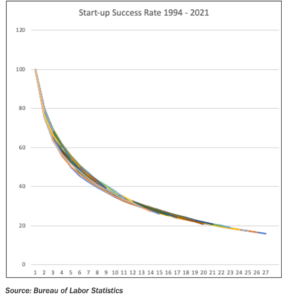In my first post, I pointed out why I started this newsletter. In a nutshell, in the past 30 years we have seen the introduction of so many tools and methodologies designed to improve the success rate of new ventures, but for the most part the success rate has not changed in 30 years.

Why is this happening? With so many new tools available, why doesn’t it change?
In my work with corporations who want to launch new products and services, as well as my work with startups, I have made an observation. Many of these processes were developed to accommodate the rapid iterative development that characterizes what I’ll call “pure” software development. (By “pure” I mean solutions in which software IS the product, not software that is a key operational component of product or service development.) Software companies are able to very quickly develop a viable product, launch it in the market, and see how it does. If it fails, they try something else. They can usually iterate like this many times in the course of a year.
This doesn’t work for companies whose products and services require capital intensive processes, complicated supply chains, or the integration of large-scale government and municipal entities. While software is a large operational component of these entities, the level of scale or complexity is vastly different from a pure software solution.
In an interview, Bill Gates noted that software is a unique domain. It gives a distorted view on how quickly things can change.
For projects that cannot change so quickly, using these processes results in under-investment in doing the work to ensure the solution will be relevant to the market when launched. It also results in rushing to create a first version of a solution prematurely, wasting significant investment in development cost and timing.
The alternative is to start with truly understanding how the people in the market make decisions. Products and services that embed this understanding from the beginning often succeed. Iterations become a continuous honing of a solution that was already pointed in the right direction, and not a start from scratch.
I’ve been successfully working with clients using this alternative approach for the last 15 years, so I know it works. But many still reject it. Why? I suspect this is because it slows the time to get to something real.
We trust what we see, but just because something is real does not mean that it is right.
We introduce a lot of risk when we don’t make sure we are going in the right direction before we sprint to the finish. For non-software focused companies, the road to bankruptcy is all too often paved with pivots and iterations that are not relevant to the market.
It doesn’t have to be that way. How can we change this paradigm on a larger scale?

